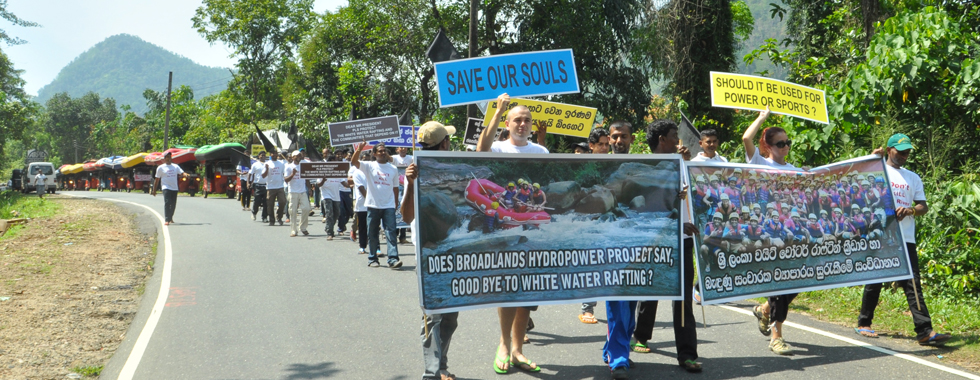News
War for water in Kithulgala
Kithulgala is Sri Lanka’s premier white-water rafting location but a hydro-power project threatens the future of this tourist attraction.
The Ceylon Electricity Board (CEB) is building the Broadland Hydropower Project on the Kelani River as a run-of-river (ROR) type power plant.
ROR plants need little or no water storage but under this project the Maskeli Oya and Kehelgamu Oya, the main tributaries providing water to the Kelani, will be blocked by dams to divert water through a 3km tunnel 5.4m in diameter to a plant to run an electricity-generating turbine. Water will then be released back to the river downstream.

Rafters take to the street
Last week, the White Water Rafters’ Association (WWRA) – whose members fear a loss of livelihood if the project goes ahead – staged a protest, parading with rubber dinghies and calling out slogans such as: “Should water be used for power or sports?”, “Does the Broadland Hydropower Project say ‘goodbye’ to white-water rafting?”.
WWRA secretary Priyantha Pushpakumara complains that the project will dam water about 5km above the main stretch of white-water rafting activity. “This stretch has 18 rapids that can be used for rafting but this diversion will destroy 13 of the rapids,” wept Priyantha.
White-water rafting at Kithulgala was started in 1995. There were only a few operators in the business initially, but that number has grown with the demand, said Channa Perera, one of the pioneers.
For thrill-seekers there used to be just the Kithulgala Resthouse providing accommodation but now there are 38 hotels in Kithulgala serving local and foreign tourists. It is estimated that nearly 100,000 tourists visit Kithulgala annually for white-water rafting.
More than 200 people are directly employed by about 10 rafting operators and the business provides another 400-odd indirect jobs, creating the backbone of a livelihood for the Kithulgala villagers.
“Kithulgala village evolved around the white-water rafting industry, and if the main attraction is affected the number of tourists will decrease, leading to a string of economic as well as social problems,” warned Priyantha.
The 35MW Broadland project expects to add 126GWh of electrical energy annually to the national grid. Hydropower is the cheapest energy source for Sri Lanka as thermal-based electricity generation is growing increasingly expensive with rising oil prices. This project is important, a CEB spokesperson said.
The CEB also gave assurances that it would continue releasing water during the daytime so that there would be enough water to continue white-water rafting. The board said the WWRA’s fears were baseless.
“We understand that the country needs energy and we are not against using water to generate the energy but we are not clear on how the water can be made available during the daytime for rafting activities as promised by the CEB. Our request to explain the mechanism of how this could be done has not been answered,” the rafters’ association responded.
Construction work on the power plant has already started and construction work is scheduled for completion in four years. The Broadlands Hydropower Project (BHP) is to be implemented with loans borrowed from Industrial & Commercial Bank of China and the Hatton National Bank.
| Clean energy vs biodiversityHydro electricity is tagged as one of the cleanest energy sources, and the cheapest. But Sri Lanka has now tapped all the major rivers blocking them to generate energy. So now the country is turning to small hydro-power plants or mini hydro-power.
The small hydro industry is typically characterized by hydro power projects with capacities less than 10MW. The Director-General of the Sustainable Development Authority (SDA), Dr. Thusitha Sugathapala, said there were more than 100 mini hydro projects in operation in Sri Lanka, generating about 250MW at present, and a recent study suggested the country has potential of about 800MW from mini-hydros. Due to environmental factors and other limitations, however, the potential from mini-hydro projects was only about 550MW. Dr. Sugathapala said there was an approval process to make certain mini-hydro projects do not damage the environment; if a project area is within a protected area the authorities did not hesitate to reject the project at once. Environmentalists oppose most of the small-scale and mini-hydro projects. These locations might not be in a designated protected area but their environmental impact is significant, environmentalists say. Recent examples include the Warathenna plant that is in one of the last remaining habitats of the critically endangered species, Labeo fisheri (Gadaya). There were also recent attempts to build a hydro power plant blocking the Aberdeen waterfall and the scenic Eli Hatha waterfalls near the Peak Wilderness. “Freshwater fish will be the worst affected due to these mini-hydro projects. Their impact can be worse than that of the large hydro projects as mini-hydro projects block smaller streams that are rich habitats for many endemic freshwater fish,” pointed out Madura de Silva, president of the Wildlife Conservation Society of Galle which conducts an island-wide fish survey. Blocking a river can change the speed of flow of water and its depth, and this will change the micro habitats that these fish need for survival. Furthermore some fish such as gobis and eels migrate up and down rivers or migrate to the sea for breeding. Any dams will block their movements and their population will be affected. “It is true that mini-hydro projects can have local environmental effects but compared with coal it is still a better option both economically and environmentally as coal emits a lot of greenhouse gases that lead to global warming,” said Asoka Abeygunawardana, Executive Director of Sri Lanka Energy Forum. “But,” he added, “often there are opportunities to reduce environmental damage when establishing mini-hydro plants, and this is an area where Sri Lanka needs to improve.” Mr. Abeygunawardana, a former adviser to the Power and Energy Ministry, said he did not view the Broadland Hydropower Plant in Kithulgala as having a large adverse impact |


